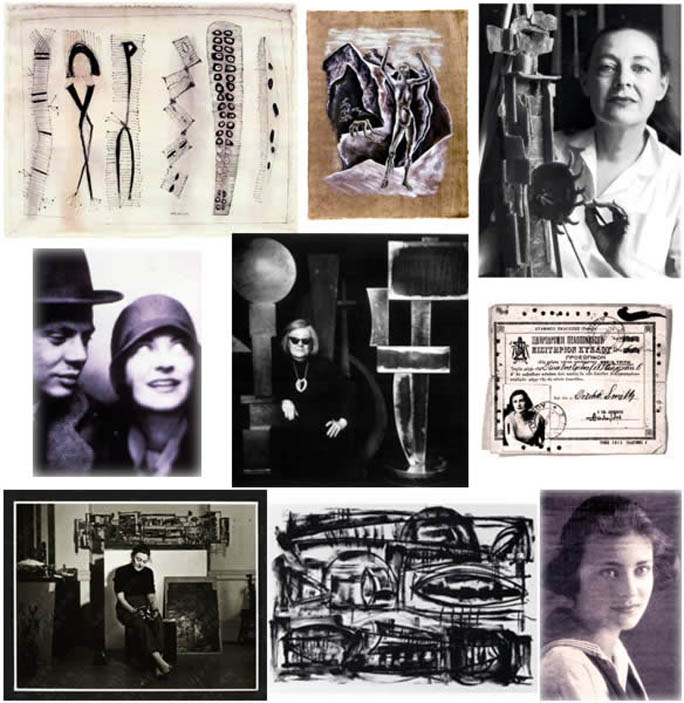Dorothy Dehner
1901-1994
“Dorothy Dehner, The Creative Process, 1930-1950,”
Kraushaar Galleries, New York,
February 24-April 10, 2015
“Dorothy Dehner, Compositions & Constructions,”
Valerie Carberry Gallery, Chicago,
January 16-March 14, 2015
Dorothy Dehner:
Sculptor and Printmaker
President, The Dorothy Dehner Foundation
After studying at the University of California, Los Angeles (1921-2), Dehner moved to New York, And in 1925, after a trip to Europe that included six months in Italy, Switzerland and Paris, and stimulated by European modernism, Dehner enrolled in New York’s Art Students League. In 1927 Dehner married the artist David Smith; both had studied painting with Jan Matulka at the ASL. In 1935 a trip to Paris, Brussels, London, Greece and the Soviet Union had a lasting impact on Dehne’s art. Both Dehner and Smith were inspired by the same images: the skeleton of a prehistoric bird from the American Museum of Natural History was the basis for Dehner’s drawing Bird of Peace (1946; priv. coll.) and Smith’s Royal Bird (1947-8; Minneapolis, MN, Walter A. Cent.). For both artists the prehistoric creature became a menacing predator, which can be related to their views about war and the destruction caused by World War II. For Dehner, however, Bird of Peace held personal associations; the spectral presence of the skeletal creature and the barren, jagged peaks below it alluded to the anguish of her private life at Bolton Landing, NY.
Dehner found a copy of Ernst Haeckel’s Kunstformen der Natur (1904), a seminal study of natural forms, and embarked on a series of drawings of microscopic forms, creating abstractions in gouache and ink. Dehner introduced a range of biomorphic forms that were related to works by such artists as Paul Klee, Joan Miro and Mark Rothko. Unlike the Surrealists, Dehner did not emphasize the disquieting aspects of her imagery, but celebrated the animate energy of these unicellular forms of life (e.g. untitled drawing from the Virgin Island Series, 1948; Cleveland, OH, Mus. A.). In 1950 Dehner left Bolton Landing and was divorced from Smith two years later. She studied at Skidmore College, Saratoga Springs, NY (1950-52), and after graduating she moved to New York City where she taught at various schools and studied engraving at S. W. Hayter’s Atelier 17. In 1952 she had her first solo exhibition at the Rose Fried Gallery and in 1955 she began experimenting with casting bronze at the Sculpture Center. Dehner’s sculpture emphasized contour, rather than mass. She assembled her works of disparate parts and approached the use of wax as a Constructivist–favoring planar elements. In the 1960s she drew on wax slabs and introduced other textures by adding small pieces of metal.
While Dehner’s sculptures are abstract, they consistently make reference to the natural world. Vertical compositions invoke a totemic presence, while the horizontal format can be viewed as a landscape. Encounter (1969, New York, Kraushaar Galleries), a work consisting of six separate sculptures, alludes to a meeting of people both in composition and in concept. The disparate totemic forms relate to one another as individuals of various sizes and proportions. Her abstract sculptures represent a personal iconography that recurs over the decades. Circles, moons, ellipses, wedges and arcs abound. By the mid-1970s Dehner changed her medium from cast metal to wood. The architectonic structure of her wooden ensembles, with thrusting verticals or stacked elements, resemble the skyline of a fanciful city. In the early 1980s Dehner began a new sculpture series of heroic proportions in Cor-Ten and black painted steel. These powerful sculptures were fabricated and based on earlier works in bronze. In the ‘90s Dehner worked with fabricators to transform some of her drawings into three-dimensional wall pieces such as The Stretcher Series. As with other artists of the New York school, Dehner’s art acknowledges that abstract symbols can communicate content that is private, but with universal implications.
